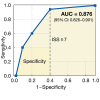Precision in pediatrics: validating the infant scalp score for TBI detection
- PMID: 40676178
- PMCID: PMC12271540
- DOI: 10.1038/s41598-025-11767-4
Precision in pediatrics: validating the infant scalp score for TBI detection
Abstract
Traumatic Brain Injury (TBI) is a common reason for pediatric emergency visits, though few cases lead to intracranial injury. This study evaluates the Infant Scalp Score (ISS) as a predictor of clinically significant TBI (ciTBI) and its role in guiding CT scan decisions for children under two at Al-Zahra and Kashani hospitals. This prospective, observational study analyzed patient outcomes using statistical modeling, including ROC curve analysis to determine optimal ISS cut-offs. Among 161 pediatric head trauma cases, 124 underwent CT imaging, identifying TBI in 25 cases (20.2%). CT decisions were guided by clinical judgment, institutional protocols, and physician discretion, with 30-day follow-up via phone consultation. ISS was calculated based on age, hematoma size, and location, classifying hematomas as small (< 1 cm), medium (1-3 cm), or large (> 3 cm). Data analysis in SPSS 25 utilized descriptive statistics and correlation tests to examine ISS-CT associations. A total of 161 pediatric patients (57% male, mean age 20.4 ± 9.8 months) with blunt head trauma were included. Among 124 children (77%) who underwent CT, 25 (20.2%) showed TBI, with 7 cases (4.34%) meeting ciTBI criteria. Hematomas ≥ 3 cm were significantly associated with higher TBI risk (OR = 3.67, p = 0.02). ISS ≥ 6 exhibited moderate predictive performance (AUC: 0.76, 95% CI: 0.62-0.85), increasing CT scan likelihood (OR = 1.73) and TBI detection (OR = 2.83). ISS ≥ 7 showed improved predictive power (AUC: 0.89, 95% CI: 0.72-0.94), reinforcing its role as the minimum predictive cut-off for ciTBI (p = 0.04). Overall, ISS demonstrated strong diagnostic accuracy (AUC = 0.876, 95% CI: 0.326-0.901), supporting its utility in guiding CT decisions and enhancing pediatric head trauma management. The Infant Scalp Score (ISS) effectively predicts TBI in children under two years old. ISS ≥ 6 identifies high-risk patients, while ISS ≥ 7 provides greater predictive accuracy, reinforcing its role in risk stratification. Larger hematomas (> 3 cm) further elevate TBI risk, emphasizing the importance of ISS in guiding CT scan decisions and reducing unnecessary radiation exposure.
Keywords: CT scan; Child; Head injury; Infant scalp score; TBI; Trauma.
© 2025. The Author(s).
Conflict of interest statement
Declarations. Ethics approval and consent to participate: The study was conducted in accordance with the Declaration of Helsinki in its current version (World Medical Association [WMA], 2013). The ethics committee of Isfahan University of Medical Sciences approved this study (approval number: IR.MUI.MED.REC.1402.474). Through the informed oral consent of patients or their first-degree relatives, data were collected and presented anonymously in this project. Competing interests: The authors declare no competing interests.
Similar articles
-
PECARN prediction rule for cervical spine imaging of children presenting to the emergency department with blunt trauma: a multicentre prospective observational study.Lancet Child Adolesc Health. 2024 Jul;8(7):482-490. doi: 10.1016/S2352-4642(24)00104-4. Epub 2024 Jun 4. Lancet Child Adolesc Health. 2024. PMID: 38843852 Free PMC article.
-
Outcome Prediction in Pediatric Traumatic Brain Injury Utilizing Social Determinants of Health and Machine Learning Methods.AJNR Am J Neuroradiol. 2025 Aug 11:ajnr.A8961. doi: 10.3174/ajnr.A8961. Online ahead of print. AJNR Am J Neuroradiol. 2025. PMID: 40789613
-
Isolated Traumatic Subarachnoid Hemorrhage on Head Computed Tomography Scan May Not Be Isolated: A Transforming Research and Clinical Knowledge in Traumatic Brain Injury Study (TRACK-TBI) Study.J Neurotrauma. 2024 Jun;41(11-12):1310-1322. doi: 10.1089/neu.2023.0253. Epub 2024 Apr 11. J Neurotrauma. 2024. PMID: 38450561 Free PMC article.
-
Can serum biomarkers be used to rule out significant intracranial pathology in emergency department patients with mild traumatic brain injury? A Systemic Review & Meta-Analysis.Injury. 2022 Feb;53(2):259-271. doi: 10.1016/j.injury.2021.10.015. Epub 2021 Oct 30. Injury. 2022. PMID: 34763896
-
Traumatic brain injury detection performance of the infant scalp score in children younger than 2 years in the pediatric emergency department.Eur J Trauma Emerg Surg. 2023 Aug;49(4):1673-1681. doi: 10.1007/s00068-022-02085-9. Epub 2022 Sep 3. Eur J Trauma Emerg Surg. 2023. PMID: 36056932 Review.
References
-
- Faul, M., Xu, L., Wald, M. M. & Coronado, V. G. Traumatic Brain Injury in the United States: Emergency Department Visits, Hospitalizations, and Deaths (Centers for Disease Control and Prevention, National Center for Injury Prevention and Control, 2010).
-
- Majdan, M. et al. Epidemiology of traumatic brain injuries in Europe: a cross-sectional analysis. Lancet Public. Health. 1(2), e76–e83 (2016). - PubMed
-
- Dayan, P. S. et al. Risk of traumatic brain injuries in children younger than 24 months with isolated scalp hematomas. Ann. Emerg. Med.64(2), 153–162 (2014). - PubMed
-
- Holmes, J. F. et al. PECARN prediction rules for CT imaging of children presenting to the emergency department with blunt abdominal or minor head trauma: a multicentre prospective validation study. Lancet Child. Adolesc. Health. 8(5), 339–347 (2024). - PubMed
Publication types
MeSH terms
LinkOut - more resources
Full Text Sources
Medical


